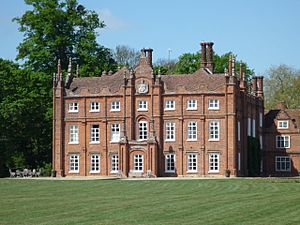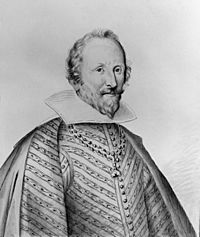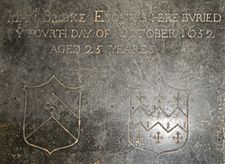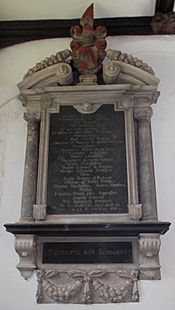Elizabeth Brooke (writer) facts for kids
Elizabeth Brooke (born January 1601 – died July 22, 1683) was an English writer known for her religious ideas. She was a strong leader of her family in East Suffolk, England, during the English Civil War and the time when the King returned to power (called the Restoration).
After she died, her minister, Nathaniel Parkhurst, wrote about her religious beliefs and practices. He also printed some of her own writings. Elizabeth Brooke was very loyal to the King and the official Church of England. However, she and her husband, Sir Robert Brooke, also worked closely with other religious groups like the Puritans. They supported ministers who didn't fully agree with the Church of England's rules, trying to keep everyone together.
Contents
Elizabeth Brooke's Early Life
Elizabeth Brooke was born Elizabeth Colepeper in 1601. Her birthplace was Great Wigsell in Salehurst, East Sussex. She was the only daughter of Thomas Colepeper, who was a Member of Parliament. Her mother was Anne Slaney, who died in 1602. Anne's father, Sir Stephen Slaney, was a rich London merchant and even the Lord Mayor of London.
Elizabeth had two full brothers, Slaney and John. John later became a very important person, known as Lord Colepeper. After her mother died, Elizabeth's father remarried. Elizabeth was raised by her grandmother, Dame Margaret Slaney. When her father died in 1613, he left money for her marriage. Her grandmother also left her a lot of money, especially for Elizabeth, to be paid when she married or turned 21.
Her Marriage and New Home
In 1620, Elizabeth married Sir Robert Brooke. He was the son of a wealthy London merchant and a former Sheriff of London. Robert had studied at Emmanuel College, Cambridge and was known for supporting religious leaders. Before marrying Elizabeth, Robert had been married to Joan, who died in 1618.
Robert's father bought him a large house and estate called Cockfield Hall in Yoxford, Suffolk. Robert completely rebuilt Cockfield Hall during his first marriage. After Elizabeth and Robert married in 1620, they lived in London for two years with Elizabeth's aunt, Dame Mary Weld. Dame Mary was very rich and religious. When she died, she left more money to Elizabeth and mentioned their daughter, Mary Brooke.
Later, Elizabeth's brother, John Colepeper, sold their family home. Sir Robert bought another house in Hertfordshire so Elizabeth could be near her friends in London. Eventually, they moved permanently to Yoxford. Their home was often visited by Dr. Richard Sibbes, a famous religious preacher. He said he enjoyed visiting the Brooke house more than any other place. By 1631, Elizabeth had written a book about Christian beliefs called A Body of Divinity.
Life at Yoxford During Tough Times
By 1637, Sir Robert and Dame Elizabeth had seven children. Their oldest daughter, Mary, was 16. The family was already familiar with Yoxford. Sir Robert had been a Member of Parliament for Dunwich three times. He also had ongoing disagreements with the people of a nearby town, Walberswick.
The years leading up to and during the English Civil War were very important for Elizabeth's brother, John Colepeper. He became a key figure in the Royalist party, which supported the King. He was knighted for his service and became an important advisor. John was elected to Parliament and at first worked to remove some officials. However, he disagreed with changes that seemed too extreme and joined the King's side in 1642.
John Colepeper became the King's Chancellor of the Exchequer (like a finance minister). He didn't approve of the King trying to arrest Members of Parliament. He fought for the King at the Battle of Edgehill and was made Master of the Rolls (a high legal position). He was later made Baron Colepeper in 1644. After the Royalists lost the war, he escaped to France and supported Prince Charles while he was in exile.
Meanwhile, Sir Robert Brooke faced challenges with the people of Walberswick. He died on July 10, 1646, at the age of 74, and was buried in Yoxford church.
Elizabeth's Widowhood and Faith
After Sir Robert's death, Dame Elizabeth, who was 45, left Suffolk for two years. She returned to Cockfield Hall around the time King Charles I was executed. She lived there for 35 more years, watching over her family's challenges. The person who wrote about her life said she was deeply upset when the King was killed. She felt it was a judgment on the nation. She wrote to a friend about her sadness and confusion, especially when some religious people seemed to think these were "glorious times."
She was very loyal to the new King, Charles II, and was sad during his exile. She refused to celebrate the holidays set by the government that had overthrown the King. She was overjoyed when the King was brought back to power in 1660. She believed deeply in the King's position and prayed for his safety and government.
Her Religious Household
Lady Brooke was known for her strong faith in the Crown and the Church of England. She was also very generous and gave to charity. Even though she always followed the official Church, she believed in being kind and including ministers who didn't completely conform. She read the scriptures constantly, along with biblical commentaries and ancient philosophers. Dr. Reynolds, the Bishop of Norwich, found her conversations excellent.
She made sure her family had daily prayers and Bible readings. On Sundays, they would discuss the sermon from church. For many years, she hired a religious teacher, called a Catechist, to visit every two weeks. This teacher would explain religious principles and test the servants' knowledge.
Family Challenges
Elizabeth's oldest son, John Brooke, who continued his father's disputes, died suddenly at age 25 in 1652. He left behind his wife, Jane. Her daughter Martha died in 1657, leaving a son named Charles. Martha's husband, William Blois, then married John's widow, Jane.
Her younger son, Robert Brooke, became the new heir. He married Anne Margarett Mildmay in 1659. As the monarchy was restored, Elizabeth's brother, Lord Colepeper, died in 1660.
Young Sir Robert Brooke had a promising career in Parliament. He inherited his father's lands and became a local leader. However, he died unexpectedly in 1669 while swimming in France. This was the hardest challenge for Dame Elizabeth. Her friends worried she wouldn't survive it. But her faith supported her, and she lived many more years, regaining her cheerful spirit. Her unmarried daughter, Mary, stayed with her, and young Charles Blois became the expected heir.
Dame Elizabeth faced lawsuits, but she won them. She became deaf in 1675 and died at Cockfield Hall on July 22, 1683. She made sure Mary could live on her estates for life, and then they would go to her grandson, Charles Blois. Her chaplain, Nathaniel Parkhurst, preached at her funeral and later published a book about her life and writings. Mary arranged for a monument in Yoxford church to honor her parents, especially her mother's good character.
Elizabeth Brooke's Writings
Nathaniel Parkhurst's book included 63 pages of Elizabeth Brooke's writings, called Observations, Experiences, and Rules for Practice. These pages contain 61 "Precepts" (rules or guidelines) with explanations. Parkhurst said these writings showed her true thoughts and would be helpful to readers.
For example, one of her precepts, number XLII, was about "Faith is the Root of other Graces." She wrote that faith is the start of all good actions and feelings. She explained that Christians pray, read, hope, and love because they believe. She felt faith was necessary for everything, even daily tasks.
Parkhurst also mentioned many other writings by Elizabeth, including her Body of Divinity from 1631. She also wrote collections of Commentaries on the Bible and a collection about the disagreements between Protestants and Catholics.
Elizabeth Brooke's Children
Sir Robert and Dame Elizabeth Brooke had three sons and four daughters:
- Mary Brooke: Born around 1621, she never married. She lived at Cockfield Hall until she died in 1693.
- Elizabeth Brooke: Born around 1622, she married Thomas Bacon. She was the mother of Nathaniel Bacon, who led a rebellion in Virginia. She died in 1647 or 1648 at about 25 years old.
- John Brooke: Born around 1626, he was the heir. He married Jane Barnardiston. He died at age 26 in October 1652. His widow, Jane, later married John's sister Martha's husband, Sir William Blois.
- Martha Brooke: Born around 1628, she married Sir William Blois. They had sons and daughters. Their son, Charles Blois, became the owner of Cockfield Hall in 1693. Martha died in 1657 at about 29.
- Anne Brooke: Died when she was a child.
- James Brooke: Died as a baby.
- (Sir) Robert Brooke: Born around 1637, he was a Member of Parliament. In 1659, he married Anne Margarett Mildmay. He died in 1669 while swimming in a river in France.






